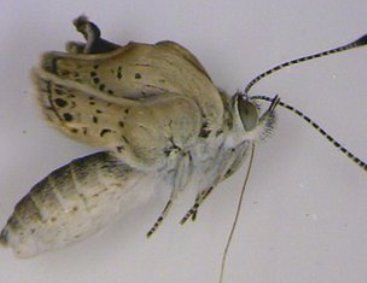
Radioactive materials released into the environment by the Fukushima nuclear disaster in Japan have caused mutations in butterflies, a study indicates.
Scientists say they've detected an increase in mutations in leg, antennae and wing shape among butterflies collected following the 2011 Fukushima accident, and that laboratory experiments have confirmed the link with the radioactive release.
Two months after the nuclear power plant accident in March 2011, Japanese researchers collected 144 adult pale grass blue butterflies from 10 locations in Japan, including the Fukushima area.
When the accident occurred, the butterflies would have been overwintering as larvae, the researchers said.
In areas with more radiation in the environment, the butterflies had much smaller wings and irregularly developed eyes, they said, a surprising finding.
"It has been believed that insects are very resistant to radiation," lead researcher Joji Otaki from the University of the Ryukyus, Okinawa, told the BBC.
"In that sense, our results were unexpected."
Previous studies have identified birds and butterflies are important tools to investigate the long-term impacts of radioactive contaminants in the environment.
"This study is important in its implications for both the human and biological communities living in Fukushima," said University of South Carolina biologist Tim Mousseau, who studies the impacts of radiation on animals and plants but was not involved in the study. (UPI)
<한글 기사>
日 원전 방사능 누출로 기형 나비 속출
지난해 3월 일본 후쿠시마 원전 사고의 방사능 물질 유출로 인해 기형 나비들이 생겨나고 있다고 한 연구가 밝혔다.
연구팀은 2011년 원전사태 이후 채집한 나비들에게서 다리와 더듬이, 날개의 모양이 변형된 사실을 발견했으며, 실험 결과 방사성 물질의 영향과 밀접한 관련이 있는 것으로 나타났다.
사건 발생 2개월 후, 일본 연구진은 114마리의 남방부전나비 (Pale grass blue butterfly) 성충을 후쿠시마 지역을 포함한 일본 전역 10곳에서 채집해 연구를 실시했다. 원전사태 당시에 이 나비들은 유충의 상태로 겨울을 나고 있었을 것이라고 연구진은 말했다.
실험 결과 많은 양의 방사능이 유출된 곳일수록, 나비가 훨씬 작은 날개와 불규칙적인 눈의 발달을 보이는 등 유전적인 변형을 보였다.
“지금까지 곤충은 방사능에 저항력이 있다고 믿어져 왔다. 그런 점에서 이 연구 결과는 예상 밖이었다”고 이 연구를 진행한 류큐 대학의 조지 오타키 교수가 말했다.
기존의 연구들은 방사능 오염물질이 환경에 미치는 장기적인 영향을 알아내는 중요한 도구로 새와 나비를 꼽아왔다.
미국 사우스 캐롤리나 대학의 생물학자 팀 무소는“이 연구가 담고 있는 함의는 사람은 물론 후쿠시마에 살고 있는 생물 공동체에 중요하다”고 말했다.










![[Hello India] Hyundai Motor vows to boost 'clean mobility' in India](http://res.heraldm.com/phpwas/restmb_idxmake.php?idx=644&simg=/content/image/2024/04/25/20240425050672_0.jpg&u=)







